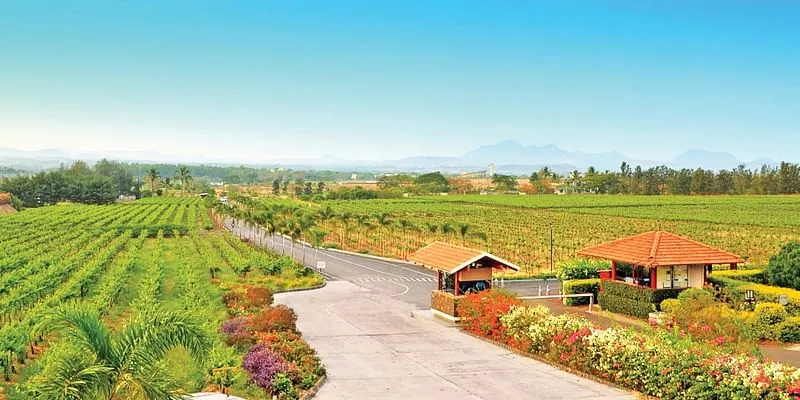From 2000 to 2020: Decoding the story of Sula, one of India’s cult wine brands
Sula Vineyards is one of the biggest wine brands in the market that sells one million cases a year and clocks a turnover of almost Rs 500 crore.
The past few months under the lockdown during the pandemic have been difficult for people. From getting locked inside homes and barred from going out to having to put a pause on our various interests, this pandemic has caused quite a stir in the lives of people.

Chaitanya Rathi, COO of Sula Vineyards
For alcohol lovers, the scenario isn’t very different.
When it comes to the Indian alcohol consumption market, whiskey, vodka, rum, and beer have always been clear winners. Crawling behind with a consumption pattern of almost a million or so is the wine industry.
While the consumption of wine has remained very low in India, the story of is one that you would want to pull up a chair and listen to. This year, the Mumbai-based brand, which started selling wines from the year 2000, celebrates its 20th anniversary.
The company is one of the top wine brands in India that clocks a turnover of almost Rs 500 crore.
The journey: From 2000 to 2020
Winemaking is a laborious process. Moreover, maintaining its taste, texture and flavour is all the more challenging an endeavour. How has the brand been able to consistently manufacture good quality wines for 20 years? “Time and patience,” says Chaitanya Rathi, COO of Sula Vineyards, emphasising that the one thing that they have done differently from others is to focus largely on the quality of wine.
He also tells SMBStory that hunger for profitable growth in a measured manner is something that the management of the company swears upon. This approach is a stark contrast to today’s startup ecosystem’s ‘growth-at-all-cost’ approach.
Sula Vineyards was founded by Rajeev Samant. After working abroad for a few years, he came back to India with the intention of starting something of his own. In 1996, he realised that he wanted to get into the wine business and realised that Nashik had the perfect climate for growing wine grapes.
His determination grew when he visited California and met with Kerry Damskey, an eminent winemaker, who enthusiastically agreed to help him start a winery. In 1997, the duo took the step of growing wine grapes in Nashik region, while also planting varietals such as the Sauvignon Blanc and Chenin Blanc that had never been planted before in India.

Rajeev Samant, Founder and CEO of Sula Vineyards
Speaking about the early years, Chaitanya says, “Wines were primarily made of table grapes and a fair amount of it was exported out of India and but not sold in India. This compelled Rajeev to manufacture a product in India but also sell it to Indians.”
Getting people to warm up to wine from India was one of the biggest challenges as wine had always been associated as a drink for the foreigners and the elite. Chaitanya says, “Initially when Sula started retailing, the average consumer in the country was more inclined towards whisky, rum, vodka, or beer. It was perceived that wine is for international dishes and cannot be consumed with Indian food.”
It took Sula over two years to obtain the necessary license to start making wine. “Marketing was also a challenge. Not only were Indian wines not heard of, but they were also more expensive than some imported wines sold in India,” he adds.
Rajeev, nevertheless, took to the task and started farming on his family land.
The labourers and the raw materials are all sourced locally, from Nashik only. The company has a total of 1,000 employees.
Manufacturing superior-quality wine
Manufacturing wine is as much a labour of love as is producing a work of art. Firstly, the grapes are handpicked and collected. Then they are crushed and put it into a filtering tank. The grape juice is fermented in these tanks where the sugar is also converted into alcohol.
Processing of grape juice depends upon the style of wine you are making (red, white or rosé). For white wine, only juice will be collected in the tank, ie, grapes are crushed in pneumatic balloon press where grape skin and seeds are removed from the grapes. This juice is then fermented to make white wine. But for red wine, the flavours, colour and tannin are in the grape skins. The whole grape, including the skin and the seeds, are utilised in making red wine. In 2019, Sula Vineyards sold over one million cases of wine. Today, they have 65 percent market share of the domestic wine market.
Over 95 percent of the wines are made to be consumed in the first couple of years, particularly the white wine. Very few wines are kept to be aged for that long. Sula Rasa and Cabernet Sauvignon are examples of wines that can be aged for more than 10 years. It exports to almost 30 countries including the US, Australia, and Italy.

Vineyard in Nashik, Mumbai
Wine Tourism
Many things that have worked for Sula Vineyards. One of them is its marketing strategy.
While India may be taking baby steps to expand the scope of the wine industry, spreading awareness has definitely brought the world a lot closer. Chaitanya says, “Our hospitality businesses, which include wine tasting events and tours of vineyards, helped establish direct touchpoints with our customers.”
The business built a tasting room in its factory in Nashik, and its annual two-day event SulaFest proved to be a wondrous crowd-puller.
From having 10 visitors a week, the vineyards now have over 1,000 visitors a day, claims Chaitanya.
“This wine tourism helped in putting Nashik on the map as well because it was earlier perceived only as a religious destination,” he says. Today, it has the potential, with several other players such as Grover Zampa, Soma Wine, and York Winery in the place, to become India’s wine destination as well.

What the post-COVID-19 era holds for the wine industry
Chaitanya, like all entrepreneurs of today, asserts the damage done by the coronavirus pandemic. “Our sales and production were halted. But we will not be critical of the government. They did what they had to do to contain the spread of the virus.”
In addition, he says that the first quarter of the year is generally slow for the company as demand for wine in India picks up during the Diwali season and lasts as long as the winter season.”
Talking about the challenges of running a business, Chaitanya says that the beer and wine industry suffer from “archaic laws.” He sees some hope in the goods and services tax (GST) and home delivery of liquor that can heal the industry from the ravages of the pandemic and poor formulation of policies.
"For instance, Sula Cabarnet Shiraz wine is sold for Rs 900 in Maharashtra and Rs 1,500 in Rajasthan because of the differential state laws. With GST coming in, there will be uniformity in prices.”
In the meantime, the brand has been able to turn COVID-19 into an opportunity.
Chaitanya explains, “When you are running a large business and growing at a rate of 15-20 percent a year, there are many things that you overlook.”
He says that as a company, they will come out stronger, efficient and more productive because the pandemic has taught them “how to do more with fewer resources.”
“There is no other way of running the business than running it in a frugal and efficient manner, and having an eye for detail," he quips.
Edited by Kanishk Singh










